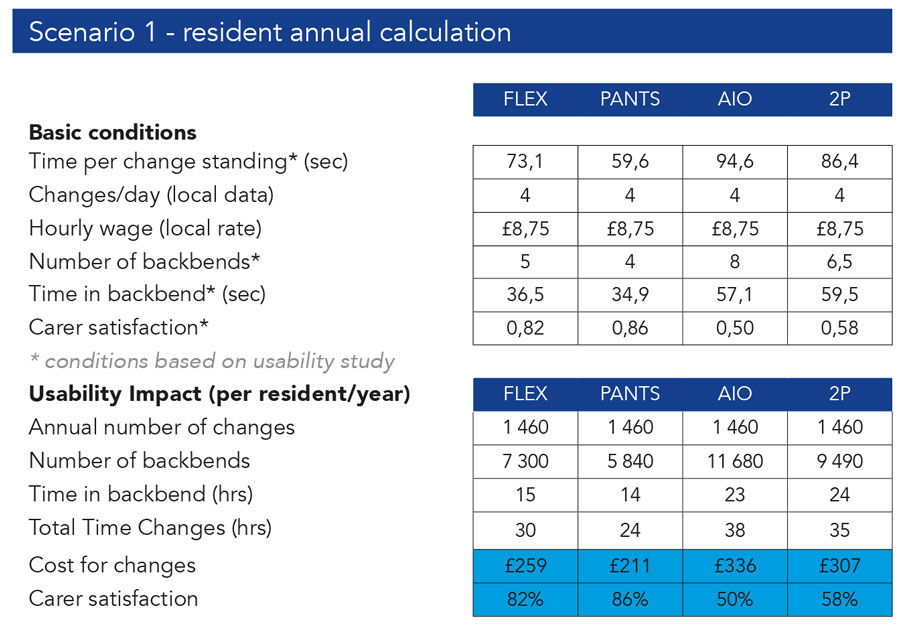Harnessing usability to choose appropriate incontinence care products
Bladder problems affect more than 200 million people worldwide according to the World Health Organization. Bowel problems are also not uncommon and it is thought that 10% of adults may experience bowel incontinence, with 1-2% reporting major symptoms.1 The NHS estimates that between 3 and 6 million people in the UK have some degree of urinary incontinence.2 Urinary incontinence is costly to society and healthcare services, both financially and in terms of physical and mental health.
Due to the pressures that incontinence places on caregivers and healthcare systems, there is a need to match patients and caregivers with appropriate, effective absorbing incontinence products that they can change easily, such as for disabled patients in a homecare environment and for professional caregivers in the institutional care environment.

Historically, evaluation of incontinence care products has focused on absorption capacity, with little emphasis on user-related and environmental factors. The needs of users and caregivers in evaluating absorbing incontinence care products have been increasingly highlighted in more recent guidelines, but to date without specific advice on methods targeting these needs.
Due to their expertise in metrology, the study of measurements, Professor Leslie Pendrill and his team at RISE Research Institutes of Sweden AB have been involved in the development of a usability score for absorbing incontinence products, in conjunction with Essity AB.
Usability is defined as the extent to which a product can be used to achieve the user’s goals and needs effectively and efficiently. Usability is an important concept for helping caregivers select products for patients and therefore should be considered when choosing incontinence care products. Usability scores are already applied to many other product types and we believe they should be encouraged for healthcare and hygiene products as well. In addition to practical applications of a usability score, recent surveys have also shown that patients have a better quality of life if they are informed and supported in their choice of product in a usable way.
The study
This research carried out by Professor Pendrill and colleagues represents the first scientific study investigating the usability of absorbent incontinence products.

It was loosely informed by a previous study of continence care which used a holistic approach to consider interactions between a product user, the product and the task. This study, along with existing standards and guidelines, highlighted the variety of factors which need to be considered when choosing the best products for individuals with urinary incontinence. Individual assessment is crucial as a product needs to be specifically matched to each carer and user; a ‘one size fits all’ approach is not suitable.
The aim of their previous study was to develop and test a new method which could be used to measure the usability of absorbent incontinence care products. More importantly, the team wanted to do this by investigating usability from a caregiver’s perspective. The final part of the study aimed to determine whether this newly defined measure of usability could be used to differentiate between product types.
The study ultimately applies a new method to guide product selection when a decision is made to change from one product to another. Both product developers and end users were involved in the design of the new usability method, meaning it is specifically tailored to suit the real-world needs of caregivers.
Urinary incontinence is costly to society and healthcare services, both financially and in terms of physical and mental health.
Study design
It was the aim of the research team at Essity AB and RISE to develop a valid and reliable method to assess usability of different types of incontinence product, to compare the different product types, and to benchmark their suitability for use in certain healthcare settings.

Once the method had been designed, it was evaluated for its levels of effectiveness, efficiency and satisfaction. The researchers carried out the evaluations using a range of different methods. These included the use of cameras to monitor task performance, test moderators to time product changes and postures, pre-defined scores to measure product fit and questionnaires to assess satisfaction scores. The usability score was based on four scores; effectiveness, or how well the product fitted the user, caregiver time, caregiver workload and caregiver satisfaction.
Effectiveness was assessed by visual inspection by a tester after each product change and included factors such as whether the product was fitted as intended by the caregiver and whether the product provided sufficient coverage for the user. Efficiency was measured as the time taken to complete a product change. This covered the time period from when the caregiver first received the product and applied protective clothing, to the end of the process. Task workload was also measured and was defined as a combination of the time and effort required by the caregiver to complete the change, for example the pressure on the spine if a caregiver is required to reposition a patient. Finally, satisfaction was assessed using a self-reported questionnaire provided to the caregiver.
The products tested included belted briefs, pull-up pants, all-in-one briefs with side fastenings and body-worn pads held in place with a mesh brief.

Study findings
The study used a person-centred approach which aimed to generate a single usability score for decision making and product benchmarking. The findings of the study showed that the usability score developed by Professor Pendrill and colleagues was able to discriminate between usability of different product types.
Usability is defined as the extent to which a product can be used to achieve the user’s goals effectively and efficiently.
Data analysis showed that products with a high usability score were more efficient in terms of changing and workload for caregivers. More specifically, belted briefs or pull-up pants were more effective than all-in-one briefs and body-worn pads held in place with a mesh brief.
When the products themselves were compared, those which performed best when changed in the standing position were TENA Pants and TENA Flex (belted briefs). TENA Flex was also ranked highly for its satisfaction score when changes were made when the patient was lying down. This is an important factor to onsider as product users will vary in their mobility and postures; if the user is always changed standing up, then belted or pull up products are suggested.

Conclusions
The work carried out by Professor Pendrill and the research team demonstrates that usability, a concept familiar from other product categories (such as computer displays), is also a suitable metric for incontinence care. Furthermore, usability can be captured in a standardised way so that different products can be benchmarked objectively.
The results of the study provide a tool to determine which incontinence product can be most easily changed in a specific situation. Using products most suited to a particular setting or patient group means that caregivers are able to quickly and easily change products. Easing the workload for caregivers will improve their working conditions and allow them to use their time and skills more effectively.

The research team has succeeded in producing a method to measure absorbing incontinence care product change in terms of the three main components of usability: efficiency, effectiveness and satisfaction. This methodology supports evaluation and interpretation of usability for decision making and makes product grading possible, in addition to enabling comparison of usability for product selection or development.
The authors of the study identify some limitations, paving the way for future investigations. For example, the researchers suggest that additional testing is needed to continue to help confirm the usability tool. The current study collected data from a simulated care environment, however testing of the concept in real-world care environments is still required in order to add weight to the newly designed usability score for absorbent incontinence products.
Overall, the concept of usability for selecting incontinence care products is one that could be applied to many settings, from private healthcare settings to the public sector, and has the potential to change the way we choose care products.
Personal Response
Do you have plans for further studies to further validate the usability tool in real-world settings?
<> At the moment there are no immediate plants to validate the usability tool in real-word settings but there has been some interest among care providers to initiate this. The key to a successful validation is to find a care provider that has the time and resources to participate and that is a challenge as the care providers are heavily under pressure.